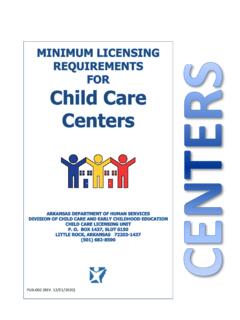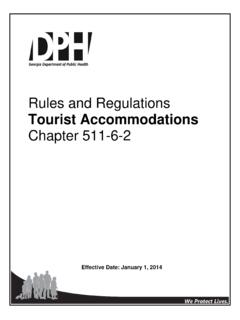Transcription of The State Health Department's Role in the Policy Process
1 Draft Draft The State Health department s Role in the Policy Process A Tool for State Health department Injury and Violence Prevention Programs Targ et Au di en ce: CDC funded State healthdepartment injury and violenceprevention programs CDC funded State healthdepartment program staffworking to prevent injuries andviolence Purpose To provide guidance to Centers for Disease Control and Prevention (CDC)- funded State Health departments about their important role in informing and evaluating Policy to prevent injuries and violence through active participation in the Policy Process . Policy as an Effective Public Health Tool to Prevent Injuries and Violence Policy interventions are important and can be effective community and societal level strategies for improving the public s Health .
2 Public Health Policy interventions can influence systems development, organizational change, social norms, and individual behavior to promote improvements in the Health and safety of a population. State Health department injury and violence prevention programs are also well-positioned to link with other public Health department programs or initiatives ( , obesity prevention, maternal and child Health , or environmental Health ) and complementary issues such as transportation, affordable housing, and sustainable healthy communities so that injury prevention goals can be incorporated into larger societal level efforts where appro pri ate . A State Health department injury and violence prevention program and its partners play a significant role in: analy zing d ata to id entify trend s and opportunities for interv ention, researc hing , id entify ing , assessing, and prioritizing polic y options that c animpac t injury and violenc e prevention, id entify ing and c onnec ting with stakehold ers to g ather feed bac k,implement c ommunic ation strategies, and to deliver relevant messagesand materials, providing science and evidence to educate decision makers about thec omponents and potential effec ts of polic ies, educ ating the public about existing polic ies or laws, and evaluating the impac t of polic Center for Injury Prev ention and Control Division of Analysis, Researc h and Prac tic e Integration Policy .
3 Organizational, Regulatory, and Legislative Policy can be defined in many ways. One applicable definition when describing public Health Policy is a law, regulation, procedure, administrative action, incentive, or voluntary practice of governments and other institutions. Policies generally operate at the systems level, are applied to large sectors or populations, a nd set the context in which individual decisions and actions are made. State hea lth departments can engage in various public Health Policy activities as outlined in CDC award documents. Other than for normal and recognized executive-legislative relationships, no CDC funds m ay be used for impermissible lobbying, including, advocating to continue or increase State Health department funding from the federal government.
4 See CDC s guidance entitled A nti-Lobbying Restrictions for CDC Grantees for more detailed information. Organizational (also known as internal policies) rules or practices established within an agency or organization, such as those developed by: Local education agencies and/or schools or school districts ,required training for teachers on teen dating violence prevention (thismay actually be a regulation promulgated by the school board, whichin many jurisdictions is an elected body). Private hospital or other healthcare delivery sites ( , physicians offices), , a systematic, required use of an evidence-in fo r medprogram to prevent Shaken Baby Syndrome as a component of ahospital stay for all new mothers. Co mmu n it y- or faith-based organizations, ( , requiring volunteercoaches to receive training and information on concussion awarenessto protect young athletes).
5 Governmental agencies, , restricting the use of government-ownedelectronic communication devices while driving by employees andcontractors (this is actually by Executive Order). Business, industry, or corporations, , Health insurance companyreimbursement policies ( Health insurance company reimbursementpolicies may be set by law). Professional associations or accrediting organizations, , CEU requirements to demonstrate competencies in public Health or e gula tory rules, guidelines, principles, or methods created by government agencies with regulation authority for products or services (government agencies receive authorization to make regulations through State laws) State , , standards regarding main drain covers and starting blocks inswimming pools.
6 Federal, , rules governing manufacturing of automobiles to meetsafety laws or ordinances Local (city or county), , statute requiring working smoke alarms beincluded in all residences. State , , laws allowing police to enforce seat belt laws withoutrequiring another violation (also known as primary enforcementseatbelt laws). Federal, , federal law that mandates the maximum allowable bloodalcohol concentration level of among persons operating a are different types of policies and each of them plays an im portant role in im proving the public s Health . Policy interventions are particularly valuable because they are systems-based and can affect populations by changing the context in which individuals take action or make decisions. They can influence decisions ( , requiring seat belt use) or they can create an environment or structures in which we live safer ( , mandating that all cars are made with front and side airbags).
7 While the behavior change may occur at the individual level, policies can set the parameters for many individual choices, or where appropriate, take more direct action at the population level. This type of population-based approach can be less expensive and more cost-effective. However, the ultimate effectiveness of a Policy intervention depends on numerous factors, including the lev el o f awareness, education, and compliance to the Policy by the public as well as resources to support a Policy s implementation ( , enforcement capacity, education and training, and availability of programs to support and enhance Policy implementation). For example, a texting while driving law may be passed in a State , but public understanding regarding the specifics of the law may impact compliance.
8 Compliance often requires enforcement. Police need to know how to determine if someone is texting and be willing to pull an offender over for texting. If none of these other Policy or practice elements are in place, the intent of the law will not be realized. CDC funds can be used for many Policy -related activities. For instance, they may be us ed by State hea lth departments to work directly on Policy -related matters across their equivalent branch of State government. Non-governmental CDC awardees and nongovernmental sub-awardees, however, have stricter parameters on the use o f federa l funds fo r any lobbying-related activities. See AR-12 and the guidance for more detail. Role of State Health Departments in the Policy Process While most State Health department staff are accustomed to playing a major role in identifying problems, some agencies or programs may be less involved in other critical domains of the Policy Process , including Policy analysis, strategy and Policy development, implementation, evaluation, and stakeholder engagement.
9 Participating in these parts of the Policy Process can help to ensure that public Health Policy solutions are based on the best available science and evidence, reflect and respond to audience needs and realities, and are updated as evidence evolves. Public Health agencies have a role to play in all types of Policy initiatives (orga nizational, regulatory, a nd legislative). CDC funds cannot be used to grass-roots lobby, or to encourage members of the public to contact their elected representatives at the federal, State , or local levels to urge support of, or opposition to , proposed or pending legislative proposals. State Health departments have an important role to play in all domains of the pol i cy process1: Problem identification analyze and communicate the problem Policy analysis identify possible interventions Strategy and Policy development prioritize interventions Policy enactment pro v id e e v id en ce a s re q u este d by d e ci si on makers Policy implementation support implementation through education, training, technical assistance, and g u i da nce 1 CDC /s tltpublichealth/ Policy / State Health departments play an important role in using scientific evidence and epidemiological data to educate both internal and external decision makers and partners about Health issues and the potential effect of a Policy intervention on a public Health issue such as injuries and violence.
10 Allowable activities related to contact with public policymakers vary by State ; therefore it is important to consult internal agency rules, a n d State and federal laws to ensure full compliance. For instance, applicable federal provisions include Sections 503(b) and (c) of the Fiscal Year 2015 Consolidated Appropriations Act, CDC s Policy AR-12, and applicable regulations found at 2 Part 200, et seq. These provisions provide restrictions and prohibit impermissible lobbying with CDC funds. State Health departments may use CDC funds to work with other agencies within the Executive Branch of their State government on Policy approaches to Health issues as part of normal executive-legislative relationships. Education gives factual information data, program description, scientific evidence of effectiveness of prevention measures, goals, current budget, people served, and accomplishments without conveying a value judgment or linking to legislative action ( , laws, pending legislation, appropriation, regulation, or other Policy decision).












